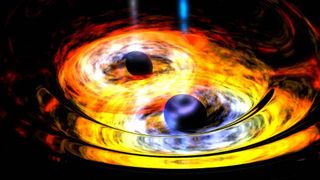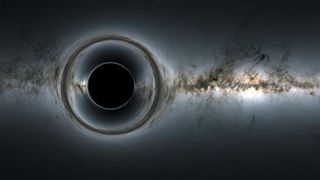A black hole formed by a lopsided merger may have gone rogue
A collision between black holes that sent one spiraling away at million 3 mph.

Astronomers have uncovered the first solid evidence that merger events between black holes can deliver a "kick" powerful enough to send a black hole spinning out of its galaxy.
The team, which included Vijay Varma, a physicist at Max Planck Institute for Gravitational Physics, Albert Einstein Institute, Germany, examined gravitational-wave data from the merger event known as GW200129 collected by the LIGO detectors and their European counterpart, Virgo. Through that analysis, the scientists discovered that the black hole created in that collision and merger had been sent hurtling through space at 3 million mph (4.8 million kph) — a finding described by one team member as "both surprising and shocking."
"When two black holes collide, they leave behind a more massive, remnant black hole. This process can impart a recoil 'kick' to the remnant black hole," Varma, lead author of a paper detailing the team's work, told Space.com.
Related: 8 ways we know that black holes really do exist
When black holes orbit each other, they emit gravitational waves — essentially gravitational radiation — that carry away energy and angular momentum as they ripple through the fabric of space. These emissions cause the orbit to shrink, leading to a collision and merger of the black holes.
If the black holes have unequal masses or spins, however, this leads to an asymmetry in the emission of gravitational waves, with them being primarily emitted in one direction. Because the basic laws of physics require that momentum has to be conserved, this asymmetry results in a large kick, causing the remnant black hole to recoil in the opposite direction.
"Black hole mergers also emit gravitational radiation, similar to astrophysical processes that emit electromagnetic radiation — light," Varma continued.
Get the Space.com Newsletter
Breaking space news, the latest updates on rocket launches, skywatching events and more!
These large kicks are expected when the merger's orbital plane precesses, or "wobbles." Orbital precession is observable as a small amplitude modification in the gravitational-wave signal. "This binary black hole system is also the first signal showing strong signs of orbital precession, whereby the orbital plane wobbles," co-author Scott Field, a mathematician at the University of Massachusetts Dartmouth, told Space.com.
Varma added that by analyzing gravitational radiation, astronomers and astrophysicists can learn about black-hole mergers. Additionally, because black holes are influential in the evolution of the galaxies, learning more about these processes could reveal how collections of stars like the Milky Way develop.
This is the first time astronomers have collected strong evidence that such a merger can eject the resulting black hole from its galaxy.

"Unlike previously observed black hole merger events, this is the first one to provide strong evidence for enormous recoil velocity. Large enough, in fact, for the remnant black hole to most likely escape from its host environment," Field said. "While we knew general relativity allowed for such extreme possibilities in principle, we did not know if the universe would produce them. The final black hole's speed is sufficiently large that it most probably exceeds the escape velocity of its host environment."
Field added that this result will have important implications for binary black hole formation scenarios, too. This is because supermassive black holes, like Sagittarius A* (Sgr A*) at the heart of the Milky Way, form through a series of collisions that scientists call hierarchical mergers. Black holes kicked from a galaxy can't partake in this process.
Mergers that give black holes the boot
The discovery of mergers lopsided enough to give black holes a powerful kick is now possible thanks to technology that allows for more precise detections of gravitational waves.
"Black hole mergers don't emit any light, so gravitational waves are the only way to observe and learn about them. We would not know about this ejected, rogue black hole without gravitational wave observatories," Field added.
Scientists aren't precisely sure where the gravitational wave event GW200129 originated, so Field points out that the team can't completely sure the black hole was ejected from its galaxy, but this is the probable outcome of it moving at such extreme speeds, according to the researchers.
"If that is indeed the case, it is now roaming around the universe by itself as a rogue black hole," Varma said.

The merger that occurred here may be a miniature version of an even more dramatic event, he noted. "A similar phenomenon happens when supermassive black holes merge, which can happen after a galactic merger," Varma said. "The final supermassive black hole can get displaced from the center of the merged galaxy, or even ejected from it, leaving behind a galaxy without a central black hole."
Although existing gravitational-wave detectors are not quite powerful enough to observe supermassive black hole mergers, the authors added that future space-based detectors like the proposed Laser Interferometer Space Antenna (LISA) mission, might be able to.
"Gravitational-wave astronomy has delivered many high-impact, truly remarkable discoveries over the past five or so years," Field said. "Before the first detection of gravitational waves, the mantra of our field had been that gravitational waves will open a new window on the universe. And this has proven to be true with each and every new LIGO observing run."
The research is described in a paper published May 12 in the journal Physical Review Letters.
You can follow Rob Lea on Twitter at @sciencef1rst. Follow us on Twitter @Spacedotcom and on Facebook.
Join our Space Forums to keep talking space on the latest missions, night sky and more! And if you have a news tip, correction or comment, let us know at: community@space.com.

Robert Lea is a science journalist in the U.K. whose articles have been published in Physics World, New Scientist, Astronomy Magazine, All About Space, Newsweek and ZME Science. He also writes about science communication for Elsevier and the European Journal of Physics. Rob holds a bachelor of science degree in physics and astronomy from the U.K.’s Open University. Follow him on Twitter @sciencef1rst.